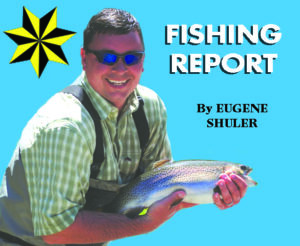 Last week, we talked about how to choose the right fly rod. The second part to that discussion is understanding what is meant by line weight of a fly rod. Line weight is commonly abbreviated by WT. By understanding how the fly fishing industry determines a line weight will help you in deciding which rod you might need.
Last week, we talked about how to choose the right fly rod. The second part to that discussion is understanding what is meant by line weight of a fly rod. Line weight is commonly abbreviated by WT. By understanding how the fly fishing industry determines a line weight will help you in deciding which rod you might need.
Rod weight and line weight greatly differ from one another. Rod weight is simply how many ounces a fly rod weighs. The line weight that is usually put on the fly line package, and on the sides of fly rods is determined by the grain weight of the first 30 feet of line. This is the industry “standard” way of determining line weight. For example if a fly line weighs 114-126 grains it is a 4 weight fly line, abbreviated 4WT. If a fly lines weighs 134-146 grains it is a 5 weight fly line, abbreviated 5WT. Fly rods, fly lines, and fly reels are designed to work with one another by matching up the numbers on the sides of the rod and the packaging. Basically by keeping like weight numbers together you have a better chance of a combination that works well together . Experimenting with different weight rods and lines sometimes ends up with a favorable results, but don’t get in a big hurry to mix and match until you get a feel for how the rod was designed to perform.
Choosing which line weight is perfect for the type of fishing you will be doing is fairly straight forward. Basically, the bigger the line weight, the bigger the fish. For example, a good setup for Noland Creek in the park might be a 3WT line, and a good setup for the Tuckasegee River would be a 5WT line or even a 6WT. For saltwater, which we are fresh out of around here, would be an 8WT to 14Wt line. Most everything we encounter on the trout streams in the mountains can be done with either a 4WT or 5Wt rod and line.

C.W Brown, from Anniston, Ala., is shown with an 18-inch Tuckasegee River Brook Trout. (Photo courtesy of Eugene Shuler)
The best fishing this week will be on the upper Nantahala River Delayed Harvest section, and Cherokee Trophy Trout Catch and Release section. We are seeing tremendous hatches of dark Caddis and Quill Gordons. So much in fact that a client and I ended up swallowing a few bugs this past week by accident. I’m not sure why trout love them so much, they didn’t taste very good to me!
Drift boat fishing on the Tuckasegee River has been very good this past week too. Scheduled Flow Releases have been good for everyone. The water has been rising mid morning and turning off by late afternoon keeping both wade fisherman and the guides with boats happy.
The Great Smoky Mountains National Park has been off to a good start. We have seen plenty of trout rising to eat dry flies by mid-morning and carrying over to late evening. The water has been on the low side compared to last year, and the fish are equally spooky. You need to wade quietly to have much success. I’ve always said, noisy wading has saved more trout than catch and release ever did!
Best flies are:
Blue Duns #14-18, Little Black Caddis in #16-18, Black Caddis Pupae in #16-18, Little Winter Stonefly nymphs in #16-20, Little Winter Stonefly dries in #14-18, Blue Winged Olives in #18-22, Quill Gordons in #12-14, egg patterns in #10-12, Rainbow Warriors in #14-20, and black midges in #22-26. For Streamer patterns try black and olive Woolly Buggers in sizes #6-8, dark brown Sculpins in #6-8, and black Rabbit Strip Zonkers in #6-10.
Fontana Lake is getting better for Walleye, and Crappie. The top choice for bank fishing is still catching fish with live night-crawler rigs working the along the edges of the shoreline. Working rattle traps and deep spinner baits across points next to deep drop offs are pulling in good sized Largemouth. and Smallmouth bass. Work them slowly and hold on. Walleye are best caught by jigging live night crawlers near rock walls in the vicinity of creek and river mouths. Trolling deep running crank baits and plastic minnows near creek and river mouths at depths of 45-60 feet are bringing up some good fish too. Walleye have yet to start their runs up river just yet, but it shouldn’t be long.
Remember to check area fishing regulations as March Madness applies to fishing too. Regulations and season closures will vary between watersheds and designations. Know the regulations before you make that first cast.
See you on the water!




